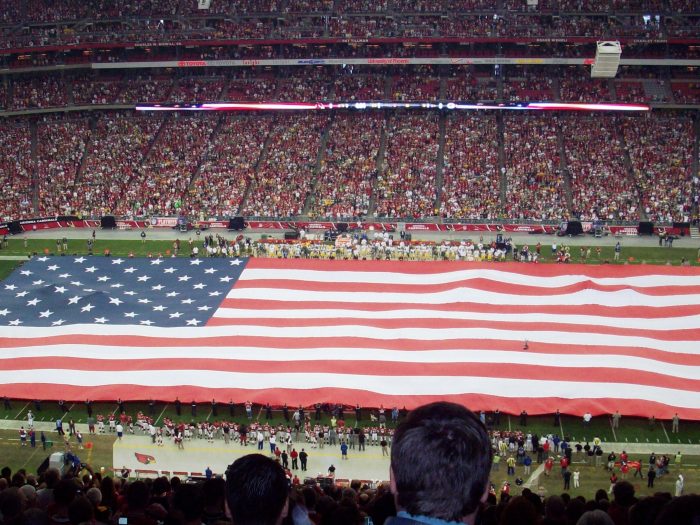NATIONAL ANTHEM CONDUCT STATUTE: 36 USC §301. Below is the US Code which governs conduct during the national anthem. This is often cited by those who have either poor reading comprehension skills or otherwise do not understand the difference between a mandate and a suggestion. In this case, 36 U.S.C. 301 states what one I do during the national anthem, not what must be done. This statute is not punitive.
§301. National anthem
(a) Designation.—The composition consisting of the words and music known as the Star-Spangled Banner is the national anthem.
(b) Conduct During Playing.—During a rendition of the national anthem—
(1) when the flag is displayed—
(A) individuals in uniform should give the military salute at the first note of the anthem and maintain that position until the last note;
(B) members of the Armed Forces and veterans who are present but not in uniform may render the military salute in the manner provided for individuals in uniform; and
(C) all other persons present should face the flag and stand at attention with their right hand over the heart, and men not in uniform, if applicable, should remove their headdress with their right hand and hold it at the left shoulder, the hand being over the heart; and
(2) when the flag is not displayed, all present should face toward the music and act in the same manner they would if the flag were displayed.
RESPECT FOR THE FLAG STATUTE: 4 U.S.C. §8. Another common argument by those opposed to national anthem protests against racism is that remaining seated or kneeling during the flag is disrespectful. However, both of these postures during the anthem are conspicuously missing from the statute which provides guidance on actions which are disrespectful to the flag.
Note how many of these items specifically designated as disrespectful to the flag are routinely done or worn by many, including those purporting to castigate Americans who kneel or remain seated during the national anthem. Bolded are the most common infractions.
§8. Respect for flag
No disrespect should be shown to the flag of the United States of America; the flag should not be dipped to any person or thing. Regimental colors, State flags, and organization or institutional flags are to be dipped as a mark of honor.
(a) The flag should never be displayed with the union down, except as a signal of dire distress in instances of extreme danger to life or property.
(b) The flag should never touch anything beneath it, such as the ground, the floor, water, or merchandise.
(c) The flag should never be carried flat or horizontally, but always aloft and free.
(d) The flag should never be used as wearing apparel, bedding, or drapery. It should never be festooned, drawn back, nor up, in folds, but always allowed to fall free. Bunting of blue, white, and red, always arranged with the blue above, the white in the middle, and the red below, should be used for covering a speaker’s desk, draping the front of the platform, and for decoration in general.
(e) The flag should never be fastened, displayed, used, or stored in such a manner as to permit it to be easily torn, soiled, or damaged in any way.
(f) The flag should never be used as a covering for a ceiling.
(g) The flag should never have placed upon it, nor on any part of it, nor attached to it any mark, insignia, letter, word, figure, design, picture, or drawing of any nature.
(h) The flag should never be used as a receptacle for receiving, holding, carrying, or delivering anything.
(i) The flag should never be used for advertising purposes in any manner whatsoever. It should not be embroidered on such articles as cushions or handkerchiefs and the like, printed or otherwise impressed on paper napkins or boxes or anything that is designed for temporary use and discard. Advertising signs should not be fastened to a staff or halyard from which the flag is flown.
(j) No part of the flag should ever be used as a costume or athletic uniform. However, a flag patch may be affixed to the uniform of military personnel, firemen, policemen, and members of patriotic organizations. The flag represents a living country and is itself considered a living thing. Therefore, the lapel flag pin being a replica, should be worn on the left lapel near the heart.
(k) The flag, when it is in such condition that it is no longer a fitting emblem for display, should be destroyed in a dignified way, preferably by burning.
